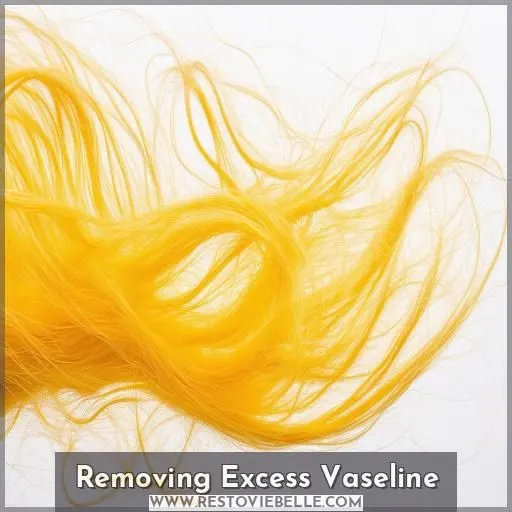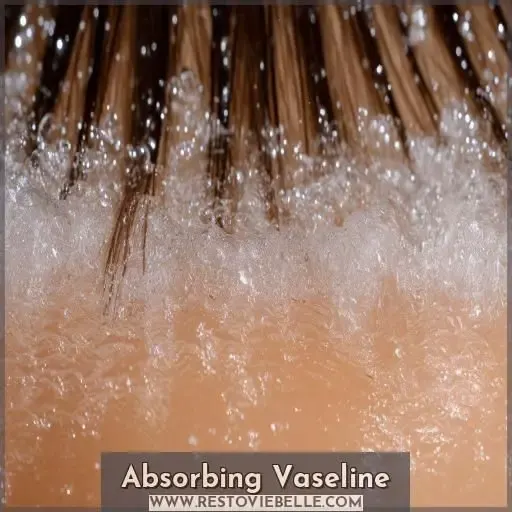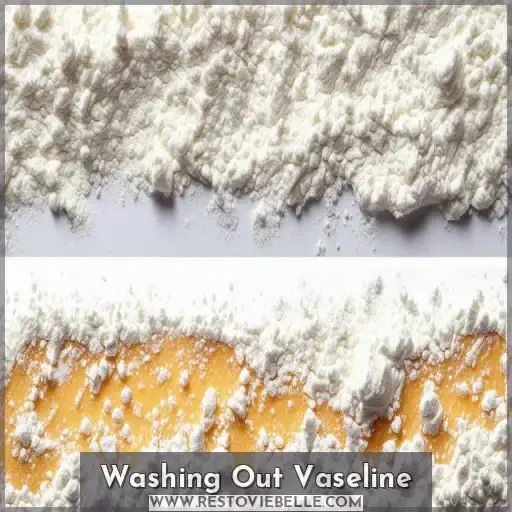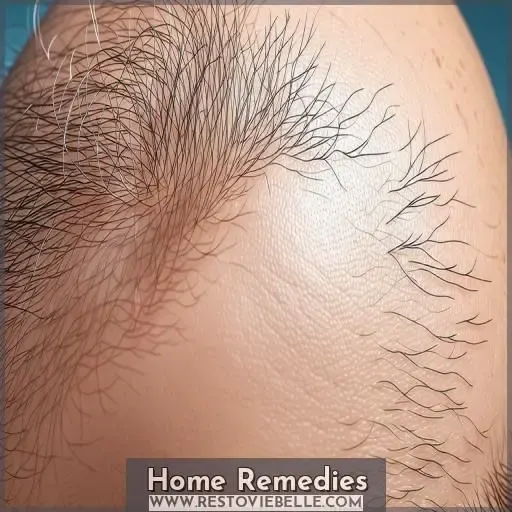This site is supported by our readers. We may earn a commission, at no cost to you, if you purchase through links.
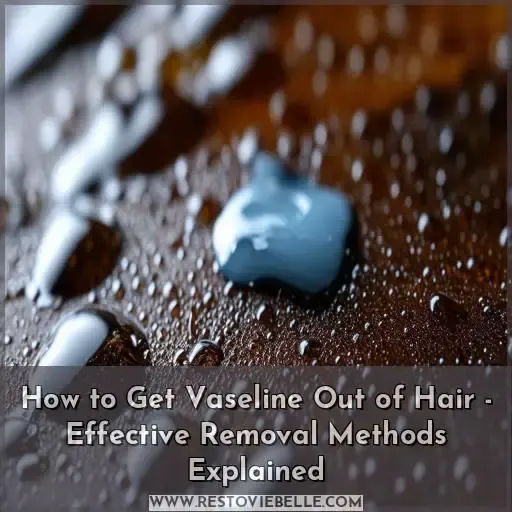 Oh no, got yourself into a sticky situation with Vaseline in your hair? Don’t panic, we have a solution for you.
Oh no, got yourself into a sticky situation with Vaseline in your hair? Don’t panic, we have a solution for you.
The key is to act quickly and use the appropriate methods.
Start by gently blotting excess petroleum jelly with paper towels or an old t-shirt.
Next, coat your hair with Cornstarch or baking soda to absorb the grease, letting it sit for 15-20 minutes before brushing out.
Follow up with a clarifying shampoo and warm water to wash away any remaining Vaseline.
With some effort (pun intended), your locks will be restored to their former glory.
But don’t stop there – keep reading to learn foolproof techniques for complete Vaseline removal.
Table Of Contents
Key Takeaways
- Removing that stubborn Vaseline from your locks is like untangling a complex knot – it requires patience and the right techniques, but the end result is oh-so-worth it! Imagine running your fingers through those luscious, grease-free tresses once more.
- Dry powders like cornstarch or baking soda are your trusty sidekicks in absorbing that excess gunk. Think of them as tiny sponges, soaking up every last bit of that pesky Vaseline before you hit the showers.
- Don’t be afraid to get a little creative with your Vaseline removal methods! Whether it’s enlisting the help of a trusty sidekick (aka your best friend) to tackle those hard-to-reach areas or trying out some homemade remedies like coconut oil or dish soap, there’s more than one way to tame those greasy locks.
- After all that hard work, your hair deserves a little TLC! Treat it to a deep conditioning session, like a well-deserved spa day for your strands. And remember, with proper care and avoiding future Vaseline mishaps, you can keep those luscious locks looking their best.
How to Get Vaseline Out of Hair?
To get Vaseline out of hair, first try absorbing it with dry powders like cornstarch or baking soda, then shampoo vigorously with a clarifying shampoo, repeating as needed. You can also use oil-based products like olive oil or dish soap to help break down the Vaseline before shampooing.
Removing Excess Vaseline
Let’s start by getting rid of the excess Vaseline from your hair.
Gently blot the greasy areas with a paper towel or an old t-shirt to absorb as much as possible.
Avoid rubbing vigorously, as this can push the Vaseline deeper into your strands.
If you’ve got a friend or family member around, enlist their help to reach the back of your head.
Once you’ve soaked up the bulk of the Vaseline, we can move on to more thorough removal techniques.
Absorbing Vaseline
To absorb the excess Vaseline from your hair, you’ll want to coat the greasy areas with a dry powder like cornstarch or baking soda. Avoid using talc-based baby powder, as the tiny particles can pose a respiratory risk if inhaled.
Using Dry Powders
Once you’ve removed the excess Vaseline, it’s time to absorb what’s left. Grab some cornstarch or baking soda and:
- Sprinkle it liberally over your greasy locks
- Gently work the powder into your hair
- Let it sit for 15-20 minutes to fully absorb
- Brush out any remaining powder when you’re done
These dry powders are cheap, effective ways to soak up that stubborn Vaseline before you shampoo.
Avoiding Talc Products
Avoid using talc-based products like baby powder to absorb Vaseline, as talc’s small particles can pose respiratory risks when inhaled. Instead, opt for safer alternatives like cornstarch or dry shampoo powder. These powders effectively soak up greasy residue without compromising your health. Once coated, gently brush away the powder, then shampoo and condition to restore your hair’s radiance.
Washing Out Vaseline
To effectively wash out Vaseline from hair, you’ll need to use a Clarifying shampoo and proper water temperature. These specialized shampoos contain stronger surfactants that can cut through the greasy buildup, while warm water helps to liquefy the Vaseline for easier removal.
Clarifying Shampoos
To wash out Vaseline, use a clarifying shampoo. Look for brands like:
- Neutrogena Anti-Residue
- Suave Daily Clarifying
- Redken Hair Cleansing Cream
- Paul Mitchell Shampoo Three
These shampoos contain surfactants that cut through grease and buildup. Massage thoroughly into damp hair, focusing on greasy areas. Rinse well.
Water Temperature
You’ll want to use warm water when washing out Vaseline, as hot water can melt and spread the greasy buildup further. Avoid cold water too, since it will cause the Vaseline to thicken and become harder to remove. Lukewarm or slightly warm water helps break down Vaseline’s water-insoluble composition for more effective cleansing.
Repeated Washing
Don’t get discouraged if the Vaseline persists after one wash. You’ll likely need to repeat the process several times:
- Shampoo hair with clarifying shampoo
- Rinse thoroughly with warm water
- Apply dry powder like cornstarch
- Shampoo again, repeating as needed
Timing and patience are key. With repeated washing, using the right shampoo, and maintaining ideal water temperature, that greasy Vaseline will eventually come out.
Home Remedies
You can try using oil-based removers like coconut or olive oil to help break down the Vaseline in your hair?.
After applying the oil, use a clarifying shampoo to wash out the loosened Vaseline.
Another option is to apply a small amount of dish soap directly to your hair before shampooing, as the degreasing agents in dish soap can help cut through the grease.
Oil-Based Removers
You can try using oils to remove Vaseline. Massage your hair with olive, coconut, or baby oil, letting it sit for 30 minutes. The oils will help break down the Vaseline. Then, shampoo thoroughly to wash it out.
| Oil | Benefits |
|---|---|
| Olive | Emollient, conditions hair |
| Coconut | Antibacterial, promotes growth |
| Baby | Mild, safe for all hair types |
Focus on areas with heavy buildup, and repeat the process as needed.
Dish Soap
If dish soap is handy, you can use it as a Vaseline remover. Squirt a small amount onto wet hair, gently massage it in, and rinse thoroughly. Avoid getting it in your eyes. Dish soap cuts through grease but can strip moisture, so use a moisturizing conditioner afterward. For coarse or color-treated hair, consider milder dish soap alternatives.
Grease Removers
If dish soap doesn’t work, you could try a skin-safe grease remover. These products are designed to break down oils and Vaseline effectively.
However, be cautious as some removers may irritate the scalp or strip hair of moisture.
Always do a patch test first and follow up with a deep conditioning treatment to restore your hair’s natural oils and prevent long-term damage.
Post-Removal Care
After removing Vaseline from your hair, it’s essential to condition it thoroughly to replenish moisture and prevent dryness. Once you’ve conditioned, gently detangle your hair with a wide-tooth comb or your fingers, being careful not to cause breakage, and allow it to air dry or use a low heat setting to avoid further damage.
Conditioning Hair
After removing Vaseline, it’s essential to nourish your hair to restore the natural oils lost during the process. This prevents future stickiness and maintains long-term hair health. Apply a deep conditioning mask or leave-in conditioner, focusing on the ends. Your child’s hair will regain its resilience with proper nourishment and time.
Detangling Hair
After washing out the Vaseline, gently blot excess moisture with a towel. Use a wide-tooth comb to detangle, working from ends to roots. Avoid pulling or excessively brushing wet hair to prevent breakage. For stubborn knots, apply a leave-in conditioner or detangling spray to ease the process. Patience and care are key to minimizing damage.
Drying Hair Gently
After removing Vaseline, gently dab hair with a clean towel to absorb moisture. Avoid rubbing, which can cause breakage. Instead, follow these tips:
- Use a microfiber towel or old T-shirt to minimize frizz
- Allow hair to air dry if possible
- If using a hair dryer, keep it on the coolest setting
- Minimize heat exposure to prevent further damage
Frequently Asked Questions (FAQs)
How can Vaseline negatively impact hair growth?
You may be surprised, but Vaseline can hinder hair growth by clogging pores and preventing moisture absorption. This greasy buildup on your scalp can lead to irritation, breakage, and excessive dandruff.
Is Vaseline-removal different for various hair types?
Vaseline removal methods can vary slightly based on hair type and texture. Thicker, coarser hair may require more rigorous cleansing, while finer hair needs a gentler approach to avoid excessive dryness or damage.
How long will it take to fully remove?
Fully removing Vaseline is no hair-raising feat—just visualize luscious, grease-free locks after 1-2 weeks of diligent shampooing, oiling, and powdering. With perseverance, you’ll soon be rocking shiny tresses once more.
Are there long-term effects from using Vaseline?
Yes, Vaseline can cause long-term hair issues if overused or misused. Buildup can lead to scalp irritation, clogged pores, and impaired hair growth. Careful removal and avoiding future use is paramount for maintaining healthy hair.
What preventative measures can be taken next time?
To prevent future mishaps, avoid using Vaseline in hair. Instead, opt for hair-friendly products like leave-in conditioners or lightweight oils.
Conclusion
Liberating your tresses from Vaseline’s grip is akin to untangling a complex knot – patience and the right techniques are key.
With dry powder absorption, clarifying shampoos, and home remedies like oil or dish soap, you’ll effectively remove every trace of the stubborn jelly.
Stay diligent, and soon your strands will regain their luster, free from the sticky confines of Vaseline entrapment.

